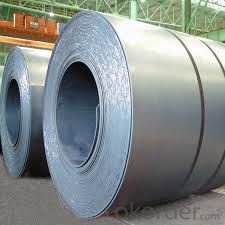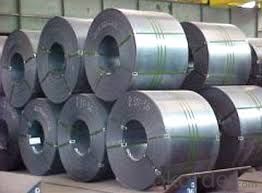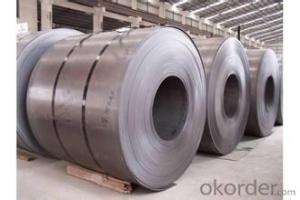hot rolled steel sheet DIN 17100 in good quality-SPHC
- Loading Port:
- Tianjin
- Payment Terms:
- TT OR LC
- Min Order Qty:
- 30 m.t.
- Supply Capability:
- 500000 m.t./month
OKorder Service Pledge
OKorder Financial Service
You Might Also Like
Product Description:
Rolled to its final dimensions while it’s hot enough to scale, our hot-rolled steel is an amalgamation of the various qualities of steel. It can be in the form of plates, sheets and coils. Our Hot-Rolled Steel Sheets and Coils are applied to a wide range of uses such as automobile, electrical appliance, machinery manufacturing, container manufacturing, shipbuilding, bridge, pipeline, and receive high acclaim from our customers for its excellent quality.
Description:
Product: | Hot Rolled Steel Coils/Sheets |
Material: | Q195,Q235,A36,SS400,S235JR,Q345,ST37-2, CCSB etc |
Standard : | JIS G3002 GB/T251B |
Technique: | hot rolled |
Thickness | 1.2mm to 200mm |
Tolerance of thickness: | :+/-0.03mm |
Width: | 750mm-2000mm |
Tolerance of width: | :+/-5.00mm (aiming to +/-2.00mm) |
Normal width: | 914mm, 1000mm, 1200mm, 1219mm, 1250mm,1500mm |
Length: | According to requirement |
Coil ID: | 508mm-610mm |
Coil Weight: | 10-25 Metric Tons |
Surface: | Black, Chromate, fingerprint resistant treatment, slight oiled or non-oiled, dry |
Port of Loading: | Tianjin/Shanghai port |
Packaging Details: | Standard export packing or according to the clients required |
Delivery Time | Within 30 days after received 30% deposit or workable L/C |
Payment Terms: | L/C,T/T |
Image:


We can ensure that stable quality standards are maintained, strictly meeting both market requirements and customers’ expectations. Our products enjoy an excellent reputation and have been exported to Europe, South-America, the Middle-East, Southeast-Asia, Africa and Russia etc.. We sincerely hope to establish good and long-term business relationship with your esteemed company.
- Q:What are the common thicknesses of steel sheets?
- The common thicknesses of steel sheets range from 0.5mm to 6mm, depending on the application and industry requirements.
- Q:Are steel sheets available in different patterns or textures?
- Yes, steel sheets are available in different patterns and textures.
- Q:What are the different sheet metal bending techniques for steel sheets?
- Steel sheets can be manipulated and shaped using various sheet metal bending techniques. These techniques help achieve desired forms and angles. Some commonly used techniques include: 1. V-bending: A V-shaped punch and die set are used to create a sharp bend in the steel sheet. The material is placed between the punch and die, and force is applied to form the desired angle. V-bending is versatile and can create different angles and shapes. 2. Air bending: In this technique, a punch presses the steel sheet into a V-shaped die without completely contacting the material. Bending is achieved by controlling the depth of penetration of the punch. Air bending allows for greater flexibility in angle adjustments and requires less force. 3. Edge bending: This technique involves bending the edge of the steel sheet to create flanges or edges with specific angles. The sheet is clamped between a punch and a die, and force is applied to bend the material along the edge. 4. Bottom bending: This technique is used to create larger bends in steel sheets. The sheet is clamped between a punch and a V-shaped die, and force is applied to bend the material around the die. Bottom bending is suitable for creating U-shaped parts or boxes. 5. Roll bending: Also known as cylindrical bending, this technique is used to create cylindrical or curved shapes in steel sheets. The sheet is passed through a set of rolls that gradually bend the material into the desired shape. Roll bending is commonly used in the production of pipes, tubes, and cylinders. 6. Coining: Coining is a precision bending technique that creates crisp, sharp bends. The steel sheet is pressed between a punch and a die, with the die featuring a sharp edge. High pressure is applied, resulting in a precise and defined bend. These are just a few of the many sheet metal bending techniques available for steel sheets. Each technique has its advantages and applications, and the choice of technique depends on factors such as the desired angle, sheet thickness, and shape complexity.
- Q:How do you cut steel sheets?
- Steel sheets can be cut using various methods such as shearing, laser cutting, plasma cutting, or using a water jet cutter. The chosen method depends on factors like the thickness of the steel sheet, desired precision, and the available equipment.
- Q:What are the common applications of galvanized steel sheets?
- Galvanized steel sheets are commonly used in various applications such as roofing, siding, automotive manufacturing, construction, and agricultural equipment.
- Q:Can the steel sheets be used for outdoor furniture?
- Yes, steel sheets can be used for outdoor furniture. Steel is a durable and weather-resistant material, making it suitable for outdoor applications. It can withstand various environmental conditions such as rain, wind, and sunlight without corroding or deteriorating quickly. Additionally, steel sheets can be molded and shaped into different furniture designs, providing both functionality and aesthetic appeal. Whether it's for tables, chairs, benches, or even decorative elements, steel sheets can be an excellent choice for outdoor furniture due to their strength, longevity, and versatility.
- Q:Can steel sheets be used for artistic or sculptural projects?
- Yes, steel sheets can be used for artistic or sculptural projects. Steel is a versatile material that offers a wide range of creative possibilities. Its strength and durability make it suitable for both indoor and outdoor artworks. Steel sheets can be cut, welded, shaped, and manipulated to create intricate designs, sculptures, and installations. Artists and sculptors often choose steel sheets for their ability to hold intricate details and withstand various weather conditions. Additionally, steel sheets can be painted, polished, or treated to achieve different textures and finishes, further enhancing the artistic appeal of the final piece. Overall, steel sheets provide artists with a robust and versatile medium to express their creativity and bring their artistic visions to life.
- Q:What is the difference between coated and uncoated steel sheets?
- The primary distinction between coated and uncoated steel sheets lies in their protective layer and surface finish. Coated steel sheets, also referred to as galvanized steel sheets, possess a layer of zinc coating to prevent corrosion and enhance durability. This zinc coating serves as a sacrificial layer, shielding the underlying steel from rust and other forms of damage. Furthermore, coated steel sheets exhibit a more polished and smoother appearance. In contrast, uncoated steel sheets do not undergo any treatment involving a protective layer. Consequently, they are more prone to corrosion, particularly when exposed to moisture or chemicals. Uncoated steel sheets are commonly utilized in situations where corrosion resistance is not a significant concern, such as in construction projects where the steel will be covered or safeguarded in some manner. Regarding cost, coated steel sheets are generally pricier than uncoated steel sheets due to the additional manufacturing process required to apply the zinc coating. Nevertheless, the increased cost is justified by the improved durability and extended lifespan of coated steel sheets. To summarize, the key disparity between coated and uncoated steel sheets lies in the presence of a protective layer. Coated steel sheets offer superior corrosion resistance and possess a smoother appearance, while uncoated steel sheets are more susceptible to corrosion and possess a rougher surface finish.
- Q:What are the standard tolerances for steel sheets?
- The standard tolerances for steel sheets can vary depending on the specific grade, thickness, and dimensions of the sheet. However, common industry tolerances for steel sheets typically range from +/- 0.010 to +/- 0.125 inches for thickness, and +/- 0.005 to +/- 0.25 inches for width and length dimensions.
- Q:What is the process of anodizing steel sheets?
- The process of anodizing steel sheets involves immersing the sheets in an electrolyte bath and passing an electric current through them. This creates an oxide layer on the surface of the steel, which enhances its corrosion resistance and improves its durability. The steel sheets are first cleaned and degreased, followed by anodizing in the electrolyte solution. The voltage applied during anodizing determines the thickness of the oxide layer, which can be further colored or sealed to achieve desired aesthetics and functional properties.
1. Manufacturer Overview |
|
|---|---|
| Location | |
| Year Established | |
| Annual Output Value | |
| Main Markets | |
| Company Certifications | |
2. Manufacturer Certificates |
|
|---|---|
| a) Certification Name | |
| Range | |
| Reference | |
| Validity Period | |
3. Manufacturer Capability |
|
|---|---|
| a)Trade Capacity | |
| Nearest Port | |
| Export Percentage | |
| No.of Employees in Trade Department | |
| Language Spoken: | |
| b)Factory Information | |
| Factory Size: | |
| No. of Production Lines | |
| Contract Manufacturing | |
| Product Price Range | |
Send your message to us
hot rolled steel sheet DIN 17100 in good quality-SPHC
- Loading Port:
- Tianjin
- Payment Terms:
- TT OR LC
- Min Order Qty:
- 30 m.t.
- Supply Capability:
- 500000 m.t./month
OKorder Service Pledge
OKorder Financial Service
Similar products
New products
Hot products
Related keywords
































